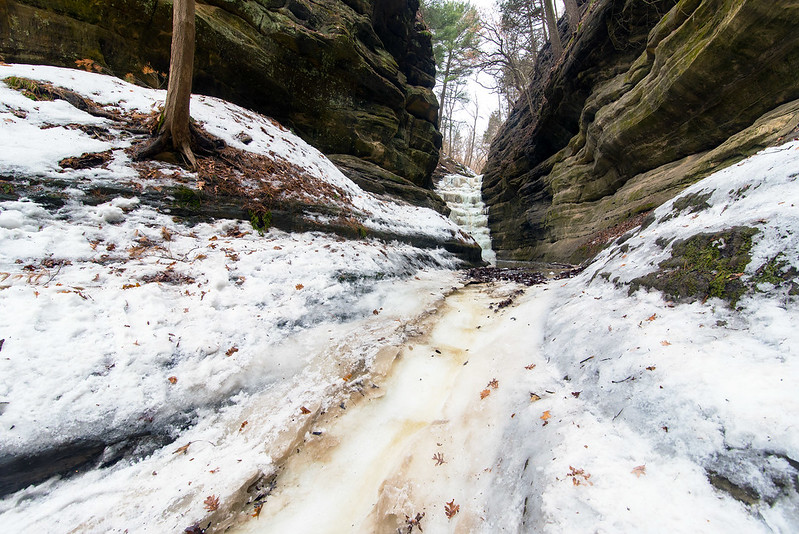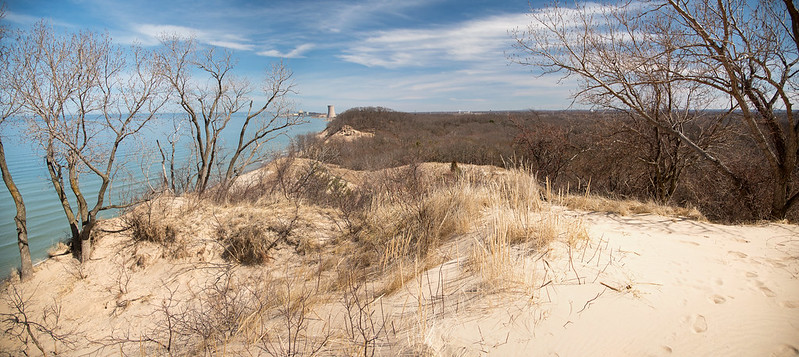
Following a week of warm weather, we decided to visit Starved Rock State Park once again, before all of the frozen waterfalls were melted. On our last trip in the very cold weather, we visited the waterfalls that generally have the most intricate ice formations - knowing they would soon be gone. On this hike, we saw the melting icefalls that we figured would still be somewhat frozen, and we were right.
These waterfalls tend to stay frozen for a bit longer than the fragile falls in LaSalle Canyon because they're thicker and in more shaded canyons. French Canyon is one of those very shady locations and generally doesn't have a huge amount of water flowing into the canyon. A heavy flow of water quickly melts the ice formations, while a more gentle one cascades over, under, or around the ice.
This canyon is generally a bit tricky to access when the stream is flowing (if you don't want wet feet), but in winter, it's extremely slippery and difficult to access. Park staff at the visitor's center have told us time and time again that it's not worth even trying to get into French Canyon in the winter - it's too dangerous. The stream flows directly on the portion of the canyon floor that is used for walking, so plenty of ice forms in this area. Without ice cleats on your boots, it's next to impossible to safely walk up into this canyon. Because we've been here many times before, we had our cleats with us.

In the photo above, you can see just how frozen the canyon floor was. No place to hold on to, so you absolutely need ice cleats, and even then, if there is snow on top of the ice, or if the cleats hit rock, you will still slide. I would hate to fall here, not only would you get wet, but you would probably continue sliding 30 or 40 feet down into the pool of water at the entrance to the canyon. I don't know how deep that water is, but you would certainly have a difficult time climbing out, and a very cold walk back to the car.
The recent high temperatures has created quite a bit of melt water, in fact, it flooded the canyon and kept us from walking too far in. We were already wet to the knees from walking through the stream at Matthiessen Park, but we weren't too certain how deep this water was, so it was best to keep out of the flooded canyon.
The melt water did allow for some very interesting colors and a nice reflection of the 40 foot tall frozen waterfall. This waterfall doesn't freefall into the canyon, it cascades over the stepped rock formations, so I think it's one of the more interesting waterfalls of the park.
Every day the warm weather eats away at the ice in all 18 canyons of Starved Rock, so if you hope to see some frozen waterfalls, it's best to visit very soon, or you will need to wait until next winter. Bring ice cleats even if you think the trails are clear - you will need them - sometimes into April.
 Certain mornings play with Lake Michigan's colors, and this was certainly one of those mornings. As we approached the end of the trail, which was once a road leading to homes and a beach access, we stood at the edge of the dune that overlooked the beach below. The dune is around 100 feet tall here, but with no people on the beach for reference, it looks as if I am standing on the beach itself.
The clouds cast shadows on the water, changing the color of the waters, and in addition, the sand is kicked up and circulated in the water, creating some deeper brown colors along the shore. While this coloration is not really unusual, it changes from moment to moment and often can't be seen from the beach itself.
Certain mornings play with Lake Michigan's colors, and this was certainly one of those mornings. As we approached the end of the trail, which was once a road leading to homes and a beach access, we stood at the edge of the dune that overlooked the beach below. The dune is around 100 feet tall here, but with no people on the beach for reference, it looks as if I am standing on the beach itself.
The clouds cast shadows on the water, changing the color of the waters, and in addition, the sand is kicked up and circulated in the water, creating some deeper brown colors along the shore. While this coloration is not really unusual, it changes from moment to moment and often can't be seen from the beach itself.
 Following what was once California Avenue, we found the end of the road - which led right off the dune to the beach below. I remember walking this road and Valley Drive when there were still homes on them. And often, after the homes were razed, we would follow a path along the top of the dunes right at the lakefront. This path has since been washed into Lake Michigan - but not because people walked on it as the park service would seem to want you to believe. People do much less damage to the dunes when they follow a path or trail than they do if you block off the traditonal paths. Some will simply walk around the sign or barricade, creating more damage as they walk around. Lake Michigan eroded the dunes here, not people walking on the dunes.
Following what was once California Avenue, we found the end of the road - which led right off the dune to the beach below. I remember walking this road and Valley Drive when there were still homes on them. And often, after the homes were razed, we would follow a path along the top of the dunes right at the lakefront. This path has since been washed into Lake Michigan - but not because people walked on it as the park service would seem to want you to believe. People do much less damage to the dunes when they follow a path or trail than they do if you block off the traditonal paths. Some will simply walk around the sign or barricade, creating more damage as they walk around. Lake Michigan eroded the dunes here, not people walking on the dunes.



















